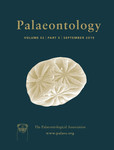Reg. Charity No. 1168330

Palaeontology relies on the description of fossil morphologies to understand the evolutionary history of life on Earth. Yet much remains unknown about the impact of fossilization processes, even though these may introduce biases into palaeobiological interpretations. Here, we report the characterization of fossilized remains of the earliest known woody plant Armoricaphyton chateaupannense preserved either in 2D (as flat carbonaceous films) or in 3D (as organo‐mineral structures) in early Devonian shales (c. 407 Ma) of the Armorican Massif on the northern margin of Gondwana. To document the fine‐scale structure and the chemistry of the tracheids of this ancient plant, we used propagation phase contrast synchrotron radiation X‐ray microcomputed tomography (PPC‐SRμCT), transmission electron microscopy (TEM) and synchrotron‐based scanning transmission X‐ray microscopy (STXM) coupled with X‐ray absorption near edge structure (XANES) spectroscopy. PPC‐SRμCT enables digital visualization of cell walls in unprecedented detail for the specimens preserved in 3D revealing structures similar to those observed in extant lignified cells, thereby strongly suggesting that the earliest woody plant A. chateaupannense originally contained lignin compounds. STXM‐based XANES and TEM data show that, whatever the preservation modes (3D vs 2D), the remaining organic matter has a chemical composition rather typical of pyrobitumen compounds, raising the possibility of an original source other than lignin. The pyrobitumen compounds also contains automorphic Ti‐nanominerals interpreted as a diagenetic feature. Altogether, the present study illustrates that anatomical and chemical preservations may not always be correlated.